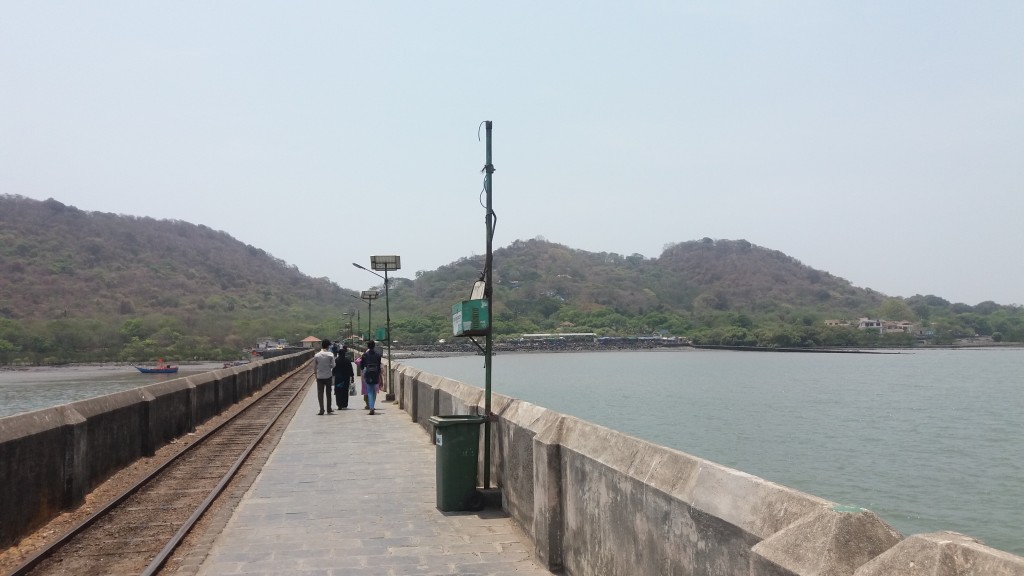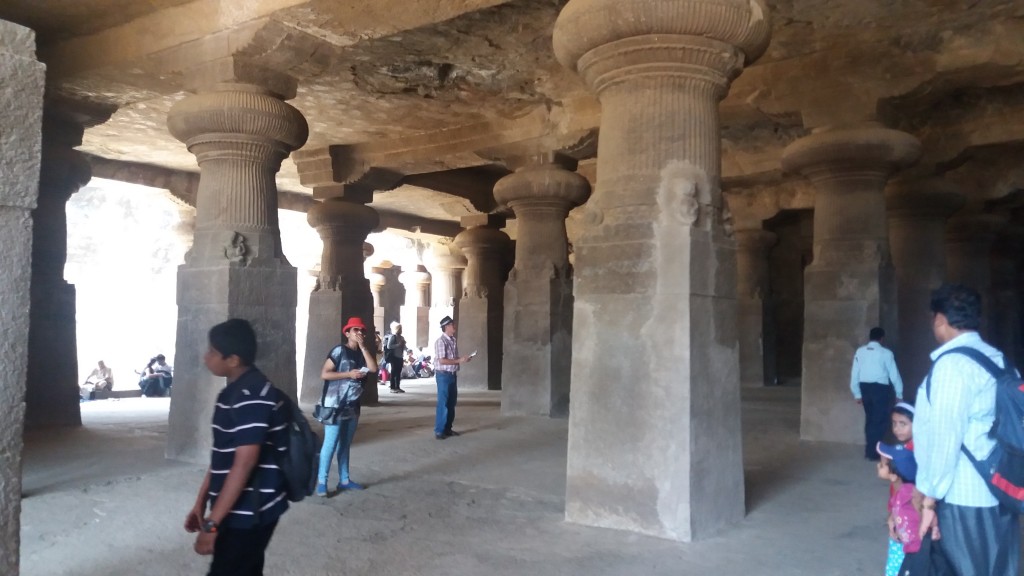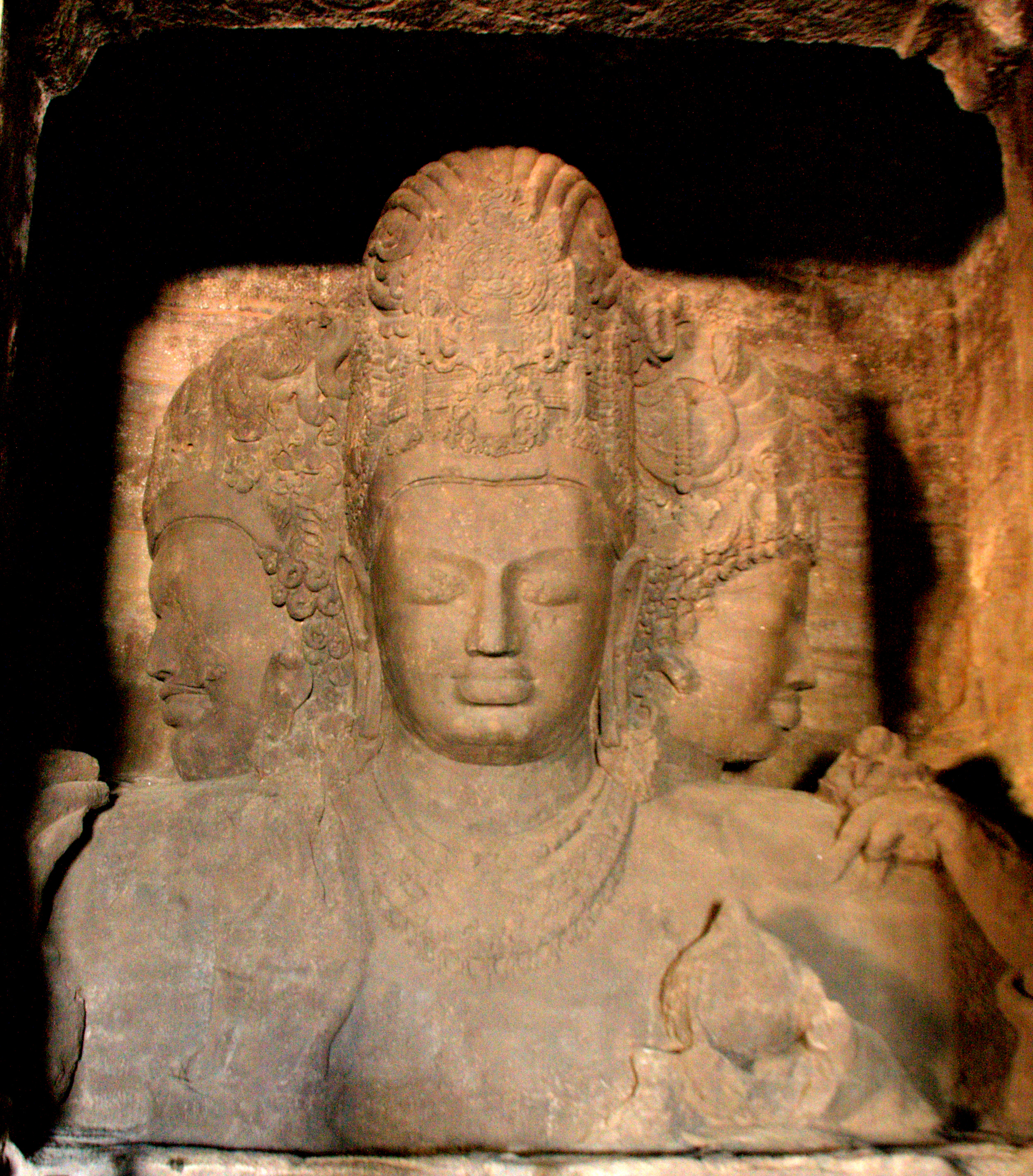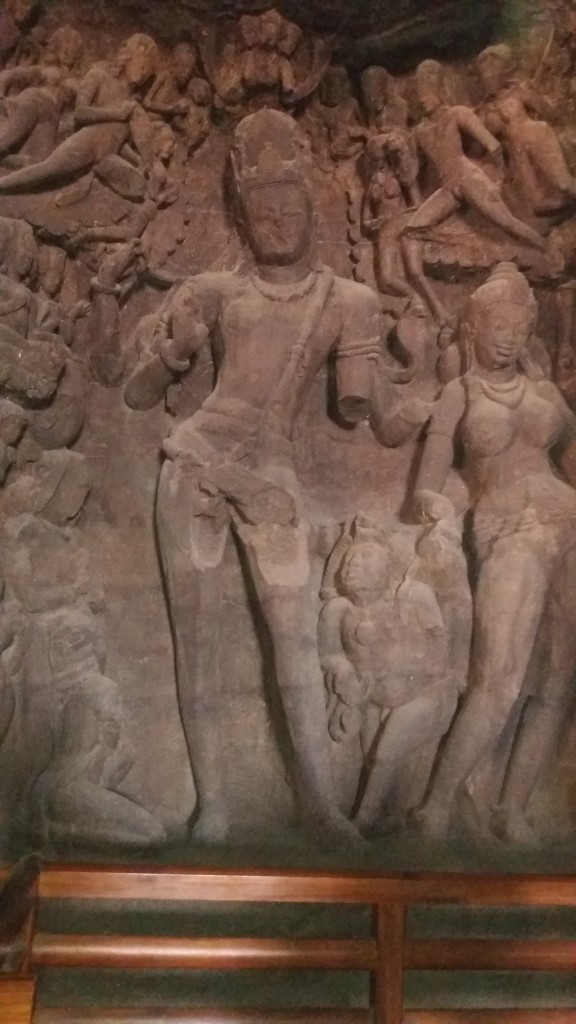Elephanta Caves, Mumbai
Summer isn’t the best time to visit Elephanta Caves, but if you don’t mind the humid coastal weather, summer can also be a good time. We visited in April and found the heat and humidity quite bearable. If you are only interesting in seeing the exquisitely crafted sculptures of Elephanta, you can visit in summer. But if you would also like to enjoy the beauty of the hills, visit after the monsoon when the trees look green and deep.

Elephanta Island seen from the boat jetty. A toy train takes visitors from the boat jetty to the foot of the hill
The Elephanta Caves are a cluster of sculpted caves in Elephanta Island, off the coast of Mumbai. The island is about 10 kms from Gateway of India. There are regular ferry services to the island from Gateway of India.
Elephanta Island (locally known as Gharapuri) consists of two hillocks separated by a narrow valley. About 1500 people live on this island.

The Main Cave on the Elephanta Island – This cave is the abode of Lord Shiva and has sculptures depicting his various forms.
The ferry takes about one hour to reach the island from Gateway of India. Boating is one of the highlights of the trip. You will get to see plenty of tanker ships moored in the port of Mumbai. The boat will drop you at the jetty. From there you can take the toy train to reach the foot of the hill or you can walk. It takes just ten minutes. The caves are a quarter mile off the foot of the hill. You have to climb 120 steps to reach the main cave temple. The narrow lane leading to the main cave is lined with shops selling idols and other artefacts.

The massive pillars of the main cave – they are the first thing that catches your attention as you enter the cave temple
The island has two groups of caves. While the large group of five caves is Hindu in characteristics, the other two caves show Buddhist influence. The Hindu caves have impressive rock cut stone sculptures representing Hindu gods, especially Shiva and his consort Parvathi.

This colossal image of Mahesh Murti (Lord Shiva) is the crowning glory of Indian sculpture. It is 18 feet high. The calm central face represents Mahadeva. Bhairava, Shiva’s destructive face is to the left. The third face represents the feminine aspect of Shiva. This image in the main cave hasn’t suffered any major damages.
The caves are carved out of solid basalt rock. They date back to 6th century AD. It is not clear under whose patronage they were built. However, it is safe to assume that they were built by a dynasty that patronized Shaivism (the worship of Shiva as supreme lord).
The main cave (Cave 1) was a major Hindu place of worship until the Portuguese captured the island in AD 1534. During Portuguese rule, the caves and the sculptures suffered serious damage. The Archeological Survey of India renovated them in 1970s and in 1987 Elephanta Caves became a UNESCO World Heritage Site.

Gangadhara Shiva Panel at Elephanta Caves – This panel shows Shiva receiving the Holy river Ganga in his locks. Standing next to him is his consort Parvathi.
Entry fee
For Indians and visitors from SAARC and BIMSTEC Countries: Rs. 40 per person
Others: US $7.5 per person
Entry is free for children up to 15 years.
History
No inscriptions of any kind have been discovered on the island. According to mythology, the caves were built by Pandavas, the heroes of the Hindu epic Mahabharata. Locals believe that they were built by super natural elements. Historians have so far not been able to attribute the caves to any particular dynasty or era.
The island got its name from a colossal elephant statue that the Portuguese found on a mound, a short distance east of the village. This statue has been moved to the Jijamata Udyaan at Byculla, Mumbai. Most Hindus left the island during the Portuguese rule and that resulted in the abandonment of the main cave used for the worship of Shiva.
Perhaps the Portuguese soldiers couldn’t appreciate the value of these cave temples. They used the sculptures of Shiva for target practice and caused considerable damage to the cave and its sculptures. Today most sculptures that you find here have lost their limbs or torso. Still, the intricate detailing found on them reveals their artistic excellence. In 1661, the Portuguese handed over the islands to the British. Luckily, the British didn’t cause any further damage to the sculptures.
The Primary Cave consists of a main chamber, two lateral chambers, courtyards, and subsidiary shrines. This complex is the abode of Shiva. The elaborate carvings and sculptures depict his various forms and scenes from his life.
If you have even a passing interest in archeology, the Elephanta Caves are worth visiting. They house some of the finest specimens of India’s celebrated rock-cut architecture. Most sculptures are in a mutilated state, but those that survive are a reflection of an ancient culture that reveled in artistic pursuits.
How to reach Elephanta Caves
There are regular boat services from Gateway of India. A return ticket costs Rs. 180 per person. Boats will drop you at the new jetty. After exploring the caves, you can return by another boat.
The first boat leaves Gateway of India at 9 am. There is a boat service every 30 minutes. The last boat leaves at about 2 pm. The first boat from Elephanta leaves at 12 pm and the last boat leaves at 5.30 pm. Make it a point to reach the boat jetty by 5 pm. You don’t want to miss the last boat to Mumbai.
Before boarding the boat, make sure that it is bound for Elephanta. There is another 30 minute boat ride. While this ride gives you an opportunity to see Mumbai from the sea, it doesn’t take you to Elephanta.
Best time to visit
Winter months are the best time to visit Elephanta Caves. The surrounding hills look enchanting during this season. Avoid the rainy season (June to September). The boat service is also suspended during this season.
Tips
Carry some water and snacks with you. While there are some nice restaurants on the island, they can be expensive. That said, don’t bring a heavy bag to the island. It is not easy to climb the steps if you have a heavy bag on your back.
Beware of monkeys
There are numerous monkeys on the island. They certainly entertain the visitors, especially children. However, they can be a nuisance at times. Don’t tease them. They can hurt you. Some visitors feed them. We actually did that because my son insisted on giving bananas to them. You only have to stretch your arm; they will come and snatch away whatever you have in your hand.